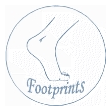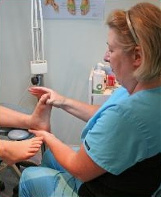Athletes Foot
Fungal infections (mycoses) of the skin and nails.
Fungal infections such as ‘athletes foot’ (tinea pedis) are caused by small micro-organisms known as fungus (yeasts, moulds and dermatophytes). The infection is not necessarily linked with poor hygiene. However, people with excessively ‘sweaty’ feet are more at risk from this type of infection. This is because the organisms that cause these infections thrive in moist, warm and dark places! Old trainers are perfect! Athlete’s foot is not restricted to athletes, but is seen in all ‘walks of life’. It is perhaps becoming more common due to more widespread use of gymnasiums and swimming pools. It is also frequently seen in patients between the age of 12 – 20, when our sweat glands can ‘work overtime’. Mycoses of the skin are relatively easy to treat with topical anti-fungal agents. However, if you find that these infections keep coming back, it may be worth checking your toe-nails for infection.
Symptoms of Mycotic nail infection:
- Separation of the nail plate from the nail bed (skin beneath the nail)
- Colour change; white, yellow or brown
- Flaky or brittle nails
- Thickened nails or a change in the shape of the nail
- Secondary problems include irritations of the surrounding skin, especially the sulcus (sides of the nail)
- In-growing toe nails can also become a problem
Treatment
Topical: applied directly to the nails
Systemic: taken orally
Many nail infections can be treated with a topical anti-fungal agent. There are now many available without prescription. This treatment is most suitable for milder infections that only affect part of the nail (towards the free edge).The substance is usually applied very regularly, often a daily application is required until the affected portion of nail has grown beyond the free edge and can be removed. Treatment should continue until the infection has ‘grown out’ and is no longer visible. However, it is often necessary for a systemic medicine to be used in order to reach infected cells deep in the nail bed or nail matrix (area below the cuticle where nail growth is generated). The nail matrix often becomes involved when the infection has been left untreated for a longer period of time but, some organisms can spread infection fast.
So, it is always a good idea to treat any infection quickly, before it spreads across the nail bed and into the nail matrix. Oral anti-mycotic drugs are only available on prescription and it is often necessary to continue taking the medication for up to 12 months (depending on the speed of nail growth, which varies between individuals). These drugs can be contra-indicated, especially if you have to take other systemic medication at the same time. Consultation with your GP is essential. Sometimes he/she will request confirmation of diagnosis by a laboratory. This means taking nail clippings to be sent for analysis. However, more serious mycotic infections are clinically obvious.
Who is at risk? Not just athletes!
- Young adults
- Those who use shared facilities, e.g the gym.
- People in occupations that demand wearing occlusive footwear such as industrial or protective shoes and Wellington boots.
- Those who attend beauty salons or ‘nail bars’ where un-sterilized instruments are used.
- Diabetic patients can also be at increased risk, especially if glucose levels are poorly controlled. This is because fungal organisms also ‘like’ high glucose levels.
Things you can do:
- Good foot hygiene is essential, fungal infections of the skin can be avoided by keeping it healthy to enable your skin to provide an effective barrier. If the skin is too dry; moisturize.
- If the skin is too moist, use anti-perspirants and/or astringents. It is especially important to ensure that areas between the toes are dried properly. Hosiery made from natural fibres, e.g. cotton, will absorb any excess moisture. However, if moist material is against the skin for long periods, the skin can become macerated and therefore more vulnerable. Change hosiery regularly and allow air to circulate around your feet as much as possible. Also, if your shoes are damp; allow them to fully dry out before wearing them again.
- Wear ‘pool-shoes’ or ‘flip-flops’ in communal showers and changing areas. Remember communal areas you use when on holiday!
- Recent research has shown that patients presenting with foot mycoses tend to have high concentrations of contaminants within their hosiery. This is worth considering if you have difficulty treating an infection, e.g. wash hosiery at higher temperatures.
If in any doubt about diagnosis or treatment of these conditions; talk to your doctor or chiropodist/podiatrist.


